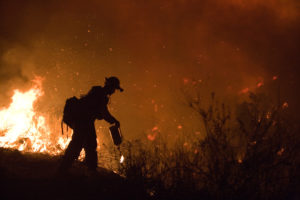 In January, Pacific Gas and Electric (PG&E), California’s largest utility, declared and subsequently filed for bankruptcy as a result of incurring as much as $30 billion in potential liabilities from transmission-caused wildfires in 2017 and 2018. The utility faces over 1,000 lawsuits and may be unable to completely handle its liabilities, possibly requiring significant state intervention. This raises critical questions about utility operations and business, and what policies are necessary to assess liability in an era of growing climate risks.
In January, Pacific Gas and Electric (PG&E), California’s largest utility, declared and subsequently filed for bankruptcy as a result of incurring as much as $30 billion in potential liabilities from transmission-caused wildfires in 2017 and 2018. The utility faces over 1,000 lawsuits and may be unable to completely handle its liabilities, possibly requiring significant state intervention. This raises critical questions about utility operations and business, and what policies are necessary to assess liability in an era of growing climate risks.
Liability for each fire is determined by California’s Department of Forestry and Fire Prevention on a case-by-case basis. Under California’s strict liability doctrine, even if PG&E is in full compliance with regulations, it still remains responsible for all damages caused by fires ignited by its equipment, which may have been the case with the Camp Fire in 2018. PG&E could be exposed to additional liability if it failed to take sufficient corrective actions after being found responsible for other small fires in 2017.
PG&E continues to have electric service obligations in areas with severe fire risks. Accordingly, a federal judge has ordered PG&E to take immediate actions to address fire risk, actions that could cost as much as $150 billion this year—quintupling rates.
While PG&E is unlikely to go under, the size of PG&E’s bankruptcy is one of the largest in energy and utility history and has significant ramifications for an industry in transition. As utilities begin to struggle with the realities of climate change, better policies are needed to protect customers and help the utility industry manage risks. PG&E’s bankruptcy presents serious challenges to California’s decarbonization goals and has wider implications for the entire energy industry in an era of increasing climate risk.
PG&E has signed more power purchase agreements from renewable energy than any other utility in the country, agreements which could now be renegotiated as a result of federal bankruptcy proceedings. Rate increases that may result from determinations of liability and equipment upgrades may significantly reduce the country’s ability to decarbonize. PG&E and other utilities must address liabilities from extreme weather events and other risks in order to meet climate goals and protect customers from the financial burden of an outdated system facing a changing climate.
PG&E is one of the largest climate change-induced bankruptcies so far, although there have been many thousands of smaller such bankruptcies (e.g., from Katrina, Sandy, etc.). And there will be… Read more »
1) State and federal policy must be developed that prioritizes distributed energy resources (DERs) in extreme fire hazard areas. Continued reliance on high-voltage transmission in these areas cannot continue, especially… Read more »
I wonder if there are some lawyers or legal scholars reading this thread who can answer a question. Does California law treat fire liability for utilities under a strict liability… Read more »
Hi Ed, Good question. Under California law, wild fire liability is treated under a strict liability standard. This recent story describes the issue in more detail: https://www.sfchronicle.com/business/article/California-s-strict-wildfire-liability-rule-13604239.php Notably, the story says… Read more »
We are going to have this conversation but we are not ready for it. Begin with fire. California and the rest of the West have been managed for a century… Read more »